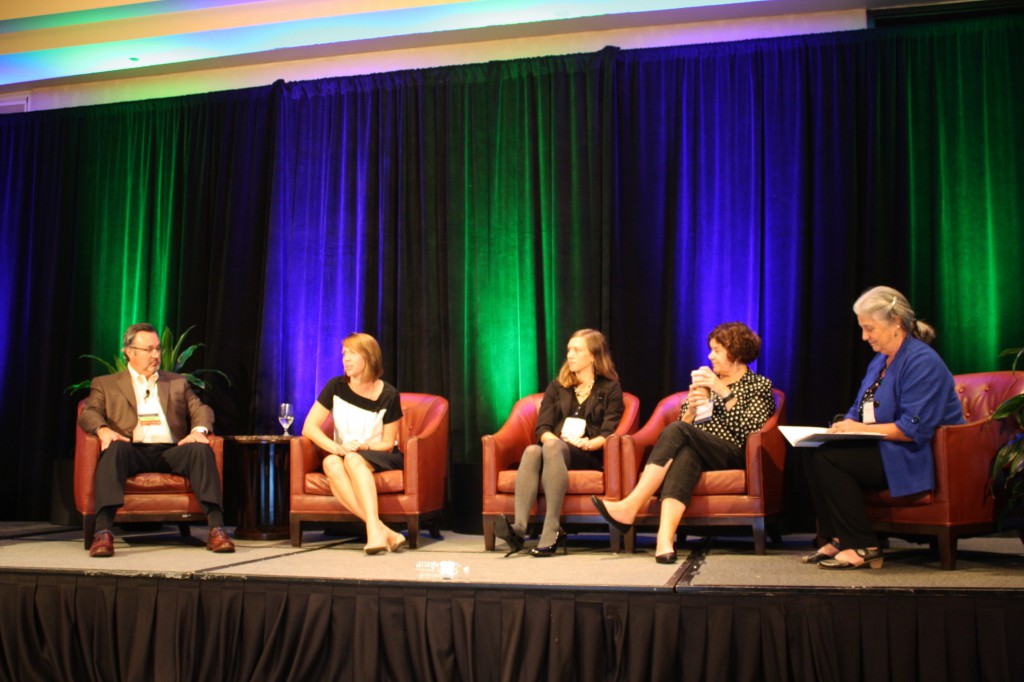
Attendees at the last session of SPC Advance heard honest responses from leading brand owners on how they are moving sustainable packaging forward within their companies. Panelists Kim Carswell from Target, Brad Rodgers from PepsiCo, Amy Duquette from HAVI Global Solutions, and Julie Zaniewski from Unilever were presented with an array of questions from the moderator, SPC Director, Nina Goodrich.
Weeks prior to the SPC Advance, SPC staff convened to brainstorm the questions that would be used during this panel. It was a fun process, and since then I had been looking forward to this panel. My expectations were exceeded as the panelists offered genuine responses and insights on sustainability from their experiences at their Fortune 500 companies.
Here are a few highlights that stuck with me:
“Packaging is a gateway to our consumers,” stated Kim Carswell, an eloquent description of how a brand owner could view packaging. Carswell went on saying that Target likes to give consumers alternative options for the products/packaging end-of-life, instead of the materials having to go to landfill. Target is constantly asking how its designs influence end-of-life.
Similarly, Amy Duquette from HAVI (which represents the packaging department of McDonald’s) said that packaging is the consumer’s last experience with the brand and that experience should be as positive as possible. Through mechanics such as the How2Recyle Label, brands can empower consumers to do the right thing, in this case recycle packaging. Amy Duquette expressed that it can often take a long time to get changes made (in this case getting the How2Recycle label on McDonald’s packaging) so you have to have realistic expectations. Companies have many internal steps which can cause obstacles when moving sustainability forward.
Correspondingly, when asked, “How do you get stuff done in your companies when it comes to sustainability?” Brad Rodgers from PepsiCo and Julie Zaniewski from Unilever agreed that their companies are fortunate to have CEOs who are committed to sustainability however that is not the whole answer. At such large, diverse companies it is critical to engage employees at every level. One person’s definition is usually at odds with another person’s s therefore it’s important to provide employees with a common definition of sustainable packaging. Once there is a common definition within the company, employees can begin to evaluate their products based on that criteria. For example, Julie Zaniewski mentioned that among cost savings and quality, sustainability can become another checkpoint on the list, leading project managers to answer the question “how does this affect the footprint?” Building on to employee engagement, Kim Carswell offered great advice to “socialize the work internally.” Kim offered a personal lesson learned to pause and layout the framework and intent so you have a greater sense of where you are going and the outcome you want to achieve.
In conclusion, a company can move sustainability forward in a variety of ways. Decisions on how to move forward need to be looked at from a diversity of perspectives and holistically. That is why sustainability can be so hard to grasp because it is all encompassing; companies have to think about sourcing, costs of materials, employee knowledge/education, unintended consequences, social and environmental impacts, recovery, reuse feasibility and so on. But it starts with one step. These steps could be visually displaying a common definition of sustainable packaging, putting into place procurement policies, such as purchasing a certain percentage of recycled content, educating staff on sustainability (SPC’s ESP course is a great resource to do this), or initiate a take-back program. I gathered that the end goal is to be holistic throughout the supply chain and collaboration among the different levels is what moves sustainable packaging forward.
Categories

